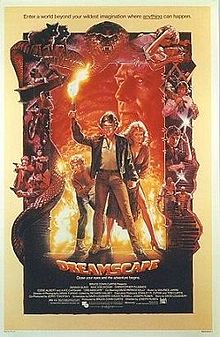It’s not uncommon in Hollywood for two different studios to release two different movies with similar premises in the same calendar year. In November 1984, Wes Craven’s A Nightmare on Elm Street, one of the most famous horror films of all time, was released. It also introduced one of cinema’s most iconic villains: Freddy Krueger, a supernatural psychopath who would murder his victims by killing them in their dreams. However, three months before Nightmare came out, a lesser known science fiction-horror film named Dreamscape was released and it happened to contain a similar premise involving people being murdered in their dreams. Both Nightmare and Dreamscape had been in development in Hollywood for years, so the question of whether anyone stole anybody else’s ideas will always be up for debate. However, in spite of some similarities between the two films, they both manage to stand on their own. Wes Craven claimed that his heart sank when Dreamscape was released first, as he feared that it would overshadow his film. Of course, A Nightmare on Elm Street would wind up becoming a far a greater success, but Dreamscape is still a very interesting little film in its own right. It’s a unique mixture of many different genres which probably tries to do too many things at once, but it’s consistently entertaining and does a stellar job at showcasing the surreal nature of dreams.
The protagonist of Dreamscape is a young psychic named Alex Gardner (Dennis Quaid), who has been a drifter for several years and makes a living by using his psychic abilities to successfully bet on horse races. Alex was once involved in a scientific research project before going under the radar, but is brought back into the fold by his former mentor, Dr. Paul Novotny (Max Von Sydow). Novotny is working on a government-funded project in which psychics are hooked into the minds of subjects while they’re sleeping. The subjects in these experiments suffer from nightmares and sleep disorders, and the psychic’s intent is to find out what’s going on inside their subject’s subconscious. Alex’s psychic abilities are so strong that he is able to enter his subjects’ dreams and interact with them. His first experiment involves linking into the mind of a sleeping construction worker who has terrifying recurring nightmares about falling off of skyscrapers.
http://www.youtube.com/watch?v=18fvEglfEFQ
However, this dream research project has a sinister side. The whole thing is funded by a powerful government agent named Bob Blair (Christopher Plummer). Blair is a close friend of the President of the United States (Eddie Albert), who keeps having recurring nightmares about causing a nuclear holocaust. In fact, the President’s nightmares are so vivid that he is seriously considering nuclear disarmament. Blair thinks that the dream-linking project would be an ideal way to use trained assassins, who could enter a subject’s dream and murder them. The trauma would be so severe that the victim would die in real life and the world would simply think they died in their sleep. In order to prevent any potential nuclear disarmament, Blair orchestrates a plan to send a murderous psychic named Tommy Ray Glatman (David Patrick Kelly) into one of the President’s nightmares to assassinate him. During the climactic dream sequence, one cannot help but draw parallels to Freddy Krueger when Tommy Ray sprouts sharp metal fingernails to rip out a police officer’s heart.
As you can see by these clips, it’s easy to assume that a lot of the cheesy special effects in Dreamscape have aged very badly. However, the imperfect effects actually work in the film’s favour and lend a surreal, nightmarish quality to the dream sequences. After all, it’s not like real dreams ever have perfect special effects. One of the most memorable qualities of any vivid dream is the feeling that something is “off” and that certain details just don’t seem to make much sense. The climactic dream sequence where Tommy Ray attempts to assassinate the President is supposed to take place in a post-apocalyptic world filled with mutants, so why does a normal police officer suddenly appear out of nowhere to approach Tommy Ray? Well, probably because weird random stuff like that always happens in dreams for no reason. One of the most striking sequences in Dreamscape is when Alex enters the dream of a young boy who has terrifying nightmares about a creature called the “Snake Man”. It does a masterful job at recreating the surreal logic of the scary nightmares you tend to experience when you’re a child. And, yes, even though the claymation Snake Man may look pretty silly now, it was one of my earliest childhood memories of being terrified while watching a film.
http://www.youtube.com/watch?v=CUSh5XLPzhA
Even though it has its frightening moments, Dreamscape is not afraid to have fun with its premise and a sense of humour about itself. In one amusing dream sequence, Alex enters the neurotic fantasies of a man who’s constantly paranoid that his wife is cheating on him. There’s also a hilariously clever sequence where Alex enters the erotic dream of a female co-worker (Kate Capshaw), who is fantasizing about sex with him. Dennis Quaid makes a very charming and likable leading man here and is ably supported by the entire cast, though it is David Patrick Kelly who steals the film as the psychotic Tommy Ray. As you’ve probably deduced, Dreamscape wants to be a horror film, a sci-fi fantasy, a political thriller and a dark comedy. Some of these elements are a bit underdeveloped, but you can’t say that the movie is not ambitious. It’s tough to know if Dreamscape would be better remembered today if it hadn’t been overshadowed by the subsequent release of A Nightmare on Elm Street. However, it’s still a very entertaining underrated gem that’s well worth checking out.

